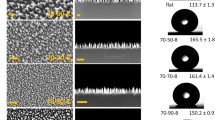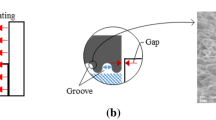Abstract
Surface wettability is the ability of a liquid to maintain contact with a solid surface, and there have been many studies aimed at controlling surface wettability for development of functional surfaces. In this study, an approach to control surface wettability is proposed by differentiating surface energy of polycarbonate in specified regions, using a combination of two surface treatments: (i) micropattern replication using selective ultrasonic imprinting and (ii) hydrophobic coating using organic silane. In both treatments, profiled masks were used to reduce surface energy in target regions where semi-hydrophobic polycarbonate surfaces were changed to hydrophobic states. Various combinations of selective ultrasonic imprinting and hydrophobic coating were investigated in terms of changes in surface wettability, by measuring contact angle (CA) behaviors on the developed surfaces. By controlling such changes, the surface wettability of regions on a single polycarbonate surface could be differentiated, allowing semi-hydrophobic (CA 87.8°), hydrophobic (CA 114.8°) and superhydrophobic (CA 155.6°) states to coexist. This high CA difference (>60°) on a single surface was then applied to enhance water-repellent characteristics so that the surface wettability could be controlled effectively. Mechanical durability of the developed hybrid surface was also discussed by investigating its CA behavior after surface abrasion.









Similar content being viewed by others
References
Patankar NA (2003) On the modeling of hydrophobic contact angles on rough surfaces. Langmuir 19:1249–1253
Quéré D (2005) Non-sticking drops. Rep Prog Phys 68:2495
Feng L, Li S, Li YS, Li HJ, Zhang L, Zhai J, Song Y, Liu B, Jiang L, Zhu D (2002) Super-hydrophobic surfaces: from natural to artificial. Adv Mater 14:1857–1860
Lafuma A, Quéré D (2003) Superhydrophobic states. Nat Mater 2:457–460
Marmur A (2004) The lotus effect: superhydrophobicity and metastability. Langmuir 20:3517–3519
Bhushan B, Jung YC (2006) Wetting, adhesion and friction of superhydrophobic and hydrophilic leaves and fabricated micro/nanopatterned surfaces. J Phys Condens Matter 20:225010
Wenzel RN (1936) Resistance of solid surfaces to wetting by water. Ind Eng Chem 28:988–994
Cassie ABD, Baxter S (1944) Wettability of porous surfaces. Trans Faraday Soc 40:546–551
Extrand CW (2002) Model for contact angles and hysteresis on rough and ultraphobic surfaces. Langmuir 18:7991–7999
Extrand CW (2003) Contact angles and hysteresis on surfaces with chemically heterogeneous islands. Langmuir 19:3793–3796
Extrand CW (2004) Criteria for ultralyophobic surfaces. Langmuir 20:5013–5018
Gao L, McCarthy TJ (2006) Contact angle hysteresis explained. Langmuir 22:6234–6237
Dorrer C, Rühe J (2006) Advancing and receding motion of droplets on ultrahydrophobic post surfaces. Langmuir 22:7652–7657
Gao L, McCarthy TJ (2007) How Wenzel and Cassie were wrong. Langmuir 23:3762–3765
Extrand CW, Moon SI, Hall P, Schmidt D (2007) Superwetting of structured surfaces. Langmuir 23:8882–8890
Gao L, McCarthy TJ (2009) An attempt to correct the faulty intuition perpetuated by the Wenzel and Cassie “laws”. Langmuir 25:7249–7255
Dorrer C, Rühe J (2009) Some thoughts on superhydrophobic wetting. Soft Matter 5:51–61
Extrand CW, Moon SI (2012) Which controls wetting? Contact line versus interfacial area: simple experiments on capillary rise. Langmuir 28:15629–15633
Paxson AT, Varanasi KK (2013) Self-similarity of contact line depinning from textured surfaces. Nat Commun 4:1492
Choi W, Tuteja A, Mabry JM, Cohen RE, McKinley GH (2009) A modified Cassie–Baxter relationship to explain contact angle hysteresis and anisotropy on non-wetting textured surfaces. J Colloid Interface Sci 339:208–216
Cansoy CE, Erbil HY, Akar O, Akin T (2011) Effect of pattern size and geometry on the use of Cassie–Baxter equation for superhydrophobic surfaces. Colloids Surf A Physicochem Eng Asp 386:116–124
Xu X, Wang X (2013) The modified Cassie’s equation and contact angle hysteresis. Colloid Polym Sci 291:299–306
Liu TL, Chen Z, Kim CJ (2015) A dynamic Cassie–Baxter model. Soft Matter 11:1589–1596
Xue CH, Jia ST, Zhang J, Ma JZ (2010) Large-area fabrication of superhydrophobic surfaces for practical applications: an overview. Sci Technol Adv Mater 11:033002
Martines E, Seunarine K, Morgan H, Gadegaard N, Wilkinson CD, Riehle MO (2005) Superhydrophobicity and superhydrophilicity of regular nanopatterns. Nano Lett 5:2097–2103
Fresnais J, Benyahia L, Poncin-Epaillard F (2006) Dynamic (de) wetting properties of superhydrophobic plasma-treated polyethylene surfaces. Surf Interface Anal 38:144–149
Zimmermann J, Reifler FA, Fortunato G, Gerhardt LC, Seeger S (2008) A simple, one-step approach to durable and robust superhydrophobic textiles. Adv Funct Mater 18:3662–3669
Amigoni S, Taffin de Givenchy E, Dufay M, Guittard F (2009) Covalent layer-by-layer assembled superhydrophobic organic-inorganic hybrid films. Langmuir 25:11073–11077
Liu Y, Choi CH (2013) Condensation-induced wetting state and contact angle hysteresis on superhydrophobic lotus leaves. Colloid Polym Sci 291(2):437–445
Kwon MH, Jee WY, Chu CN (2015) Fabrication of hydrophobic surfaces using copper electrodeposition and oxidation. Int J Precis Eng Manuf 16:877–882
Myint MTZ, Kitsomboonloha R, Baruah S, Dutta J (2011) Superhydrophobic surfaces using selected zinc oxide microrod growth on ink-jetted patterns. J Colloid Interface Sci 354:810–815
Levkin PA, Svec F, Fréchet JM (2009) Porous polymer coatings: a versatile approach to superhydrophobic surfaces. Adv Funct Mater 19:1993–1998
Hosono E, Fujihara S, Honma I, Zhou H (2005) Superhydrophobic perpendicular nanopin film by the bottom-up process. J Am Chem Soc 127:13458–13459
Shi F, Chen X, Wang L, Niu J, Yu J, Wang Z, Zhang X (2005) Roselike microstructures formed by direct in situ hydrothermal synthesis: from superhydrophilicity to superhydrophobicity. Chem Mater 17:6177–6180
Heckel M, Schomburg WK (2004) Review on micro molding of thermoplastic polymers. J Micromech Microeng 14:R1–14
Guo LJ (2007) Nanoimprint lithography: methods and material requirements. Adv Mater 19:495–513
Liu B, He Y, Fan Y, Wang X (2006) Fabricating super-hydrophobic lotus-leaf-like surfaces through soft-lithographic imprinting. Macromol Rapid Commun 27:1859–1864
Berendsen CW, Škereň M, Najdek D, Černý F (2009) Superhydrophobic surface structures in thermoplastic polymers by interference lithography and thermal imprinting. Appl Surf Sci 255:9305–9310
Chu D, Nemoto A, Ito H (2014) Effects of geometric parameters for superhydrophobicity of polymer surfaces fabricated by precision tooling machines. Microsyst Technol 20:193–200
Mekaru H, Takahashi M (2009) Ultrasonic nanoimprint on engineering plastics. J Vac Sci Technol A 27:785–792
Seo YS, Park K (2012) Direct patterning of micro-features on a polymer substrate using ultrasonic vibration. Microsyst Technol 18:2053–2061
Lee HJ, Park K (2014) Development of composite micro-patterns on polymer film using repetitive ultrasonic imprinting. Int J Precis Eng Manuf Green Technol 1:341–345
Sackmann J, Burlage K, Gerhardy C, Memering B, Liao S, Schomburg WK (2015) Review on ultrasonic fabrication of polymer micro devices. Ultrasonics 56:189–200
Lee CH, Jung PG, Lee SM, Park SH, Shin BS, Kim JH, Hwang KY, Kim KM, Ko JS (2010) Replication of polyethylene nano-micro hierarchical structures using ultrasonic forming. J Micromech Microeng 20:035018
Cho YH, Seo YS, Moon IY, Kim BH, Park K (2013) Facile fabrication of superhydrophobic poly (methyl methacrylate) substrates using ultrasonic imprinting. J Micromech Microeng 23:055019
Choi SJ, Suh KY, Lee HH (2008) Direct UV-replica molding of biomimetic hierarchical structure for selective wetting. J Am Chem Soc 130:6312–6313
Nishimoto S, Kubo A, Nohara K, Zhang X, Taneichi N, Okui T, Liu Z, Nakata K, Sakai H, Murakami T, Abe M, Komine T, Fujishima A (2009) TiO2-based superhydrophobic–superhydrophilic patterns: fabrication via an ink-jet technique and application in offset printing. Appl Surf Sci 255:6221–6225
Christoph H, Mareen BM, Vera B, Moritz T, Sarah J, Alexander W, Andreas F (2012) The role of substrate wettability in nanoparticle transfer from wrinkled elastomers: fundamentals and application toward hierarchical patterning. Langmuir 28:16745–16750
Yao CW, Alvarado JL, Marsh CP, Jones BG, Collins MC (2014) Wetting behavior on hybrid surfaces with hydrophobic and hydrophilic properties. Appl Surf Sci 290:59–65
Jung W, Lee HJ, Park K (2015) Investigation of localized heating characteristics in selective ultrasonic imprinting. Int J Precis Eng Manuf 16:1999–2004
Verho T, Bower C, Andrew P, Franssila S, Ikkala O, Ras RH (2011) Mechanically durable superhydrophobic surfaces. Adv Mater 23:673–678
Acknowledgment
The authors would like to thank Prof. Yong-Hak Cho and Ms. Shin-Hyung Kim at Seoul National University of Science and Technology for their support in performing silane coating. The authors also appreciate Prof. Chang-Hwan Choi at Stevens Institute of Technology for his kind advice and valuable discussion.
Author information
Authors and Affiliations
Corresponding author
Ethics declarations
Funding
This research was funded by the Basic Science Research Program through the National Research Foundation (NRF) funded by the Ministry of Education, Republic of Korea (Grant Number NRF-2013R1A1A2A10004709).
Conflict of interest
The authors declare that they have no conflict of interest.
Rights and permissions
About this article
Cite this article
Lee, HJ., Park, K. Variable wettability control of a polymer surface by selective ultrasonic imprinting and hydrophobic coating. Colloid Polym Sci 294, 1413–1423 (2016). https://doi.org/10.1007/s00396-016-3902-y
Received:
Revised:
Accepted:
Published:
Issue Date:
DOI: https://doi.org/10.1007/s00396-016-3902-y




